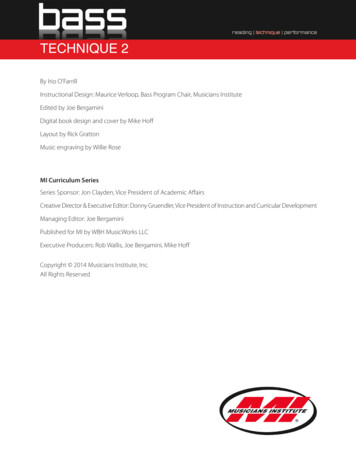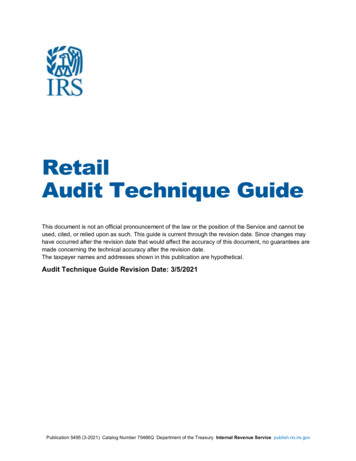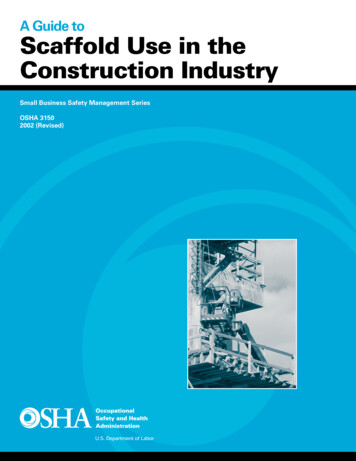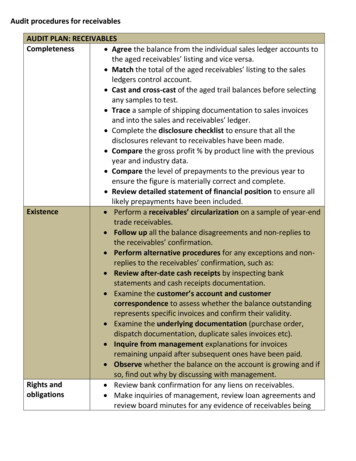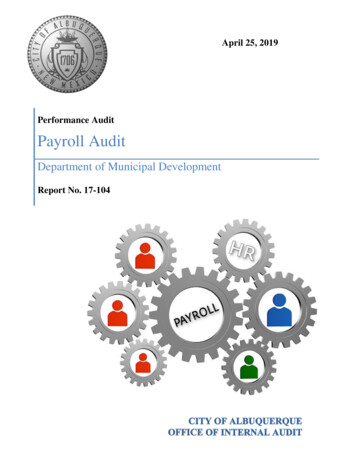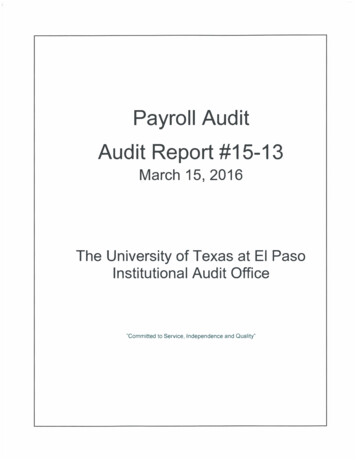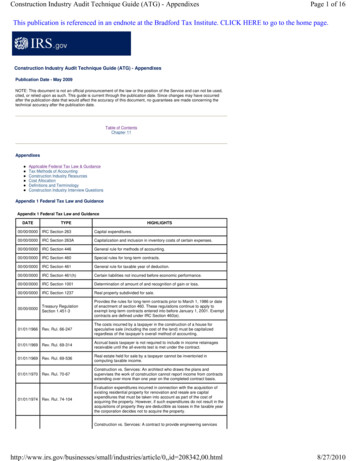
Transcription
Construction Industry Audit Technique Guide (ATG) - AppendixesPage 1 of 16This publication is referenced in an endnote at the Bradford Tax Institute. CLICK HERE to go to the home page.Construction Industry Audit Technique Guide (ATG) - AppendixesPublication Date - May 2009NOTE: This document is not an official pronouncement of the law or the position of the Service and can not be used,cited, or relied upon as such. This guide is current through the publication date. Since changes may have occurredafter the publication date that would affect the accuracy of this document, no guarantees are made concerning thetechnical accuracy after the publication date.Table of ContentsChapter 11Appendixes Applicable Federal Tax Law & GuidanceTax Methods of AccountingConstruction Industry ResourcesCost AllocationDefinitions and TerminologyConstruction Industry Interview QuestionsAppendix 1 Federal Tax Law and GuidanceAppendix 1 Federal Tax Law and GuidanceDATETYPEHIGHLIGHTS00/00/0000IRC Section 263Capital expenditures.00/00/0000IRC Section 263ACapitalization and inclusion in inventory costs of certain expenses.00/00/0000IRC Section 446General rule for methods of accounting.00/00/0000IRC Section 460Special rules for long-term contracts.00/00/0000IRC Section 461General rule for taxable year of deduction.00/00/0000IRC Section 461(h)Certain liabilities not incurred before economic performance.00/00/0000IRC Section 1001Determination of amount of and recognition of gain or loss.00/00/0000IRC Section 1237Real property subdivided for sale.00/00/0000Treasury RegulationSection 1.451-3Provides the rules for long-term contracts prior to March 1, 1986 or dateof enactment of section 460. These regulations continue to apply toexempt long-term contracts entered into before January 1, 2001. Exemptcontracts are defined under IRC Section 460(e).01/01/1966Rev. Rul. 66-247The costs incurred by a taxpayer in the construction of a house forspeculative sale (including the cost of the land) must be capitalizedregardless of the taxpayer’s overall method of accounting.01/01/1969Rev. Rul. 69-314Accrual basis taxpayer is not required to include in income retainagesreceivable until the all-events test is met under the contract.01/01/1969Rev. Rul. 69-536Real estate held for sale by a taxpayer cannot be inventoried incomputing taxable income.01/01/1970Rev. Rul. 70-67Construction vs. Services: An architect who draws the plans andsupervises the work of construction cannot report income from contractsextending over more than one year on the completed contract basis.Rev. Rul. 74-104Evaluation expenditures incurred in connection with the acquisition ofexisting residential property for renovation and resale are capitalexpenditures that must be taken into account as part of the cost ofacquiring the property. However, if such expenditures do not result in theacquisitions of property they are deductible as losses in the taxable yearthe corporation decides not to acquire the property.01/01/1974Construction vs. Services: A contract to provide engineering ries/article/0,,id 208342,00.html8/27/2010
Construction Industry Audit Technique Guide (ATG) - AppendixesRev. Rul. 80-18does not qualify as a long-term contract because it does not requiretaxpayer to actually construct or build anything even though his servicesare functionally related to activities, which may be the subject of longterm contracts. Thus, such taxpayer is not entitled to use either thecompleted contract or percentage of completion method.Rev. Rul. 81-277The payment by a contractor of money to a buyer in exchange for arelease of the buyer’s claim against the contractor for failure to fulfill thecontract for construction of a plant constitutes a return of capital ratherthan gross income to the buyer. The cost basis of the plant is adjusteddownward to reflect the payment.Rev. Rul. 82-134Construction vs. Services: A taxpayer, who by contract furnishesengineering services and construction management to clients, is notentitled to use the completed contract method of accounting. Taxpayerprimarily performs services and construction supervision and is notrequired to actually construct anything.01/01/1984Rev. Rul. 84-32Construction vs. Services: A painting contractor who paints industrial andcommercial buildings, highways and railroad bridges, and industrialplants is not entitled to use the completed contract method of accounting.Taxpayer’s contract is not a long-term contract because it does notrequire him to construct, build, or install anything.12/29/1986Rev. Rul. 86-149Construction costs of completed homes and costs of construction inprogress are capital expenditures under IRC Section 263. Taxpayerscannot inventory such costs under the LIFO inventory method.02/27/1989Rev. Rul. 89-25Houses that a homebuilder used for models and/or sales offices were notsubject to an allowance for depreciation.04/13/1992Rev. Rul. 92-28IRC Section 460(e)(1) permits a taxpayer to use different methods ofaccounting for exempt and nonexempt contracts within the same trade orbusiness.10/25/1993Rev. Rul. 93-70An escrow agent that performs an oversight function with respect to aconstruction project and makes payments on behalf of the owner andgeneral contractor is required to file information returns (Form 1099) forpayments of reportable income.Rev. Proc. 87-56This revenue procedure specifies class lives and recovery periods forproperty subject to depreciation under the general depreciation systemprovided in IRC Section168. This Revenue Procedure lists depreciableassets used within the construction industry in Asset Class 15, Table 2,2ith a MACRS life of 5 years.04/27/1992Rev. Proc.92-29Provides procedure for a real estate developer to obtain theCommissioner’s consent to use an alternative method (other than underIRC Section 461(h)) for determining when common improvement costsmay be included in the basis of properties sold for purposes ofdetermining gain or loss resulting from the sales.06/05/1995Rev. Proc. 95-27Provides safe harbor for certain structural modifications to a building thatwill not be treated as a demolition under IRC Section 280B.01/08/2001Rev. Proc. 2001-10Qualifying taxpayers with average annual gross receipts of 1 million orless are excepted from an accrual method of accounting under IRCSection 446 and accounting for inventories under IRC Section 471.05/06/2002Rev. Proc. 2002-28This procedure provides an exception from using an accrual method ofaccount and accounting for inventories to qualifying taxpayers in certaineligible businesses with average annual gross receipts of 10 million orless.05/06/2004Rev. Proc. 2004-34Provides procedures under which accrual basis taxpayers may defer theinclusion in income of payments received (or amounts due and payable)in on taxable year for services to be performed in a subsequent year.This Revenue Procedure supersedes Revenue Procedure 71-2109/26/1983W.C. & A.N. MillerDevelopment Company v.Commissioner, 81 T.C.619 (1983)Taxpayer improperly changed to a LIFO method of accounting for itshome construction costs. The individual homes, which the taxpayer sold,were real estate and did not constitute “merchandise” within the meaningof Treasury Regulation Section 1.471-1.07/28/1986Homes by Ayres v.Commissioner, 795 F.2d832 (9th Cir. 1986), aff’g,T.C. Memo. 1984-475The taxpayer was not allowed to use the LIFO method of accounting forits completed homes and homes under construction because realproperty is not considered “merchandise. Tract home developers, as amatter of law, cannot maintain inventories for tax purposes.02/24/1993Tollis v. Commissioner,T.C. Memo. 1993-63, aff’d,46 F.3d 1132 (6th Cir.1995)Ordinary income vs. capital gain from the sale of real property.Taxpayers were in the trade or business of selling real estate and,therefore, they realized ordinary income, not capital gain, from their salesof le/0,,id 208342,00.htmlPage 2 of 168/27/2010
Construction Industry Audit Technique Guide (ATG) - Appendixes06/23/1994Carpenter v.Commissioner, T. C.Memo. 1994-289Taxpayer is not entitled to use the cash method of accounting forexpenses related to construction of houses that were unsold at the endof the taxable year, but instead must capitalize the costs of constructionof such unsold houses.06/27/1994Walsh v. Commissioner,T.C. Memo. 1994-293,aff’d in unpublishedopinion, 76 AFT 2d 955771.Ordinary income vs. capital gain from the sale of real property. Courtheld that the taxpayer was in the trade or business of selling real estateand that income from the sale of such property was thus ordinary.08/08/1994Hustead v. Commissioner,T.C. Memo. 1994-374,aff’d without opinion, 61F.3d 895 (3d Cir. 1995)Expenditures (legal expenses related to challenge of zoning variance)incurred in connection with land development must be capitalized perIRC Section 263A.02/02/1995Von-Lusk v.Commissioner, 104 T.C.207 (1995)Preliminary land development costs (obtaining building permits andvariances, negotiating permit fees, property taxes etc.) werenondeductible capital expenditures per IRC Section 263A.09/16/1997Pierce v. Commissioner,T.C. Memo. 1997-411A taxpayer engaged in buying and developing land for sale to residentialbuilders is not entitled to use the lower of cost or market method, aninventory method, because real property may not be inventoried.02/09/1998Foothill Ranch CompanyPartnership v.Commissioner, 110 T.C.94 (1998)Sales Contract vs. Construction Contract: The construction of thebuildings or improvements to the real property did not have to be theprimary subject matter of the contract in order for a taxpayer to use thepercentage of completion method. It only had to be necessary for thetaxpayer to fulfill its contractual obligations.01/07/1999Reichel v. Commissioner,112 T.C. 14 (1999)Real estate taxes paid by a real estate developer were required to becapitalized per IRC Section 263A, even though no positive steps to begindeveloping the parcels had occurred, because the taxpayer acquired theparcels with the intent to develop them.08/30/1999Olstein v. Commissioner,T.C. Memo. 1999-290Lots purchased from a predecessor were capital assets because theproperty was not held for sale to customers in the ordinary course of thetaxpayer’s trade or business. Sale of these lots thus resulted in capitalgain.10/07/1999Hancock v. Commissioner,T.C. Memo. 1999-336Ordinary income vs. capital gain from the sale of real property. The eightlots sold by the taxpayer in liquidation of her real estate developmentbusiness were in the ordinary course of her trade or business and thusthe tax losses from the sales were ordinary losses.07/17/2000Tutor-Saliba Corporationv. Commissioner, 115 T.C.1 (2000)Disputed claims are part of contract price for percentage of completionmethod of accounting as soon as it is reasonably estimated that theclaims would be received, not when the all-events test is met.03/14/2001Hutchinson v.Commissioner, 116 T.C.172 (2001)Pursuant to Rev. Proc. 92-29 (alternative cost method), the taxpayercould allocate estimated clubhouse construction costs to bases in thelots sold. Under the general economic performance rule, however,taxpayer could not include estimated future-period interest expense inthe bases of the lots because neither law nor contract required taxpayerto obtain interest-bearing debt for such common improvements.04/17/2001Raymond v.Commissioner, T.C.Memo. 2001-96Taxpayer was denied the use of the installment method of accounting onhomes the taxpayer built and sold in exchange for promissory notesbecause such sales were considered dealer dispositions.07/10/2008Koch Industries v. US, 102AFTR 2d2008-5219 (DCKan 2008)The taxpayer was permitted the use of PCM for the “Pavement andStructures Warranties”. The court found them to be constructioncontracts subject to Section 460.DATETYPEPage 3 of 16HIGHLIGHTS00/00/0000IRC Section 263Capital expenditures.00/00/0000IRC Section 263ACapitalization and inclusion in inventory costs of certain expenses.00/00/0000IRC Section 446General rule for methods of accounting.00/00/0000IRC Section 460Special rules for long-term contracts.00/00/0000IRC Section 461General rule for taxable year of deduction.00/00/0000IRC Section 461(h)Certain liabilities not incurred before economic performance.00/00/0000IRC Section 1001Determination of amount of and recognition of gain or loss.00/00/0000IRC Section 1237Real property subdivided for sale.00/00/0000Treasury RegulationSection 1.451-3Provides the rules for long-term contracts prior to March 1, 1986 or dateof enactment of section 460. These regulations continue to apply toexempt long-term contracts entered into before January 1, 2001. es/article/0,,id 208342,00.html8/27/2010
Construction Industry Audit Technique Guide (ATG) - AppendixesPage 4 of 16contracts are defined under IRC Section 460(e).01/01/1966Rev. Rul. 66-247The costs incurred by a taxpayer in the construction of a house forspeculative sale (including the cost of the land) must be capitalizedregardless of the taxpayer’s overall method of accounting.01/01/1969Rev. Rul. 69-314Accrual basis taxpayer is not required to include in income retainagesreceivable until the all-events test is met under the contract.01/01/1969Rev. Rul. 69-536Real estate held for sale by a taxpayer cannot be inventoried incomputing taxable income.01/01/1970Rev. Rul. 70-67Construction vs. Services: An architect who draws the plans andsupervises the work of construction cannot report income from contractsextending over more than one year on the completed contract basis.Rev. Rul. 74-104Evaluation expenditures incurred in connection with the acquisition ofexisting residential property for renovation and resale are capitalexpenditures that must be taken into account as part of the cost ofacquiring the proper
Construction Industry Interview Questions Appendix 1 Federal Tax Law and Guidance Appendix 1 Federal Tax Law and Guidance DATE TYPE HIGHLIGHTS 00/00/0000 IRC Section 263 Capital expenditures. 00/00/0000 IRC Section 263A Capitalization and inclusion in inventory costs of certain expenses. 00/00/0000 IRC Section 446 General rule for methods of accounting. 00/00/0000 IRC

